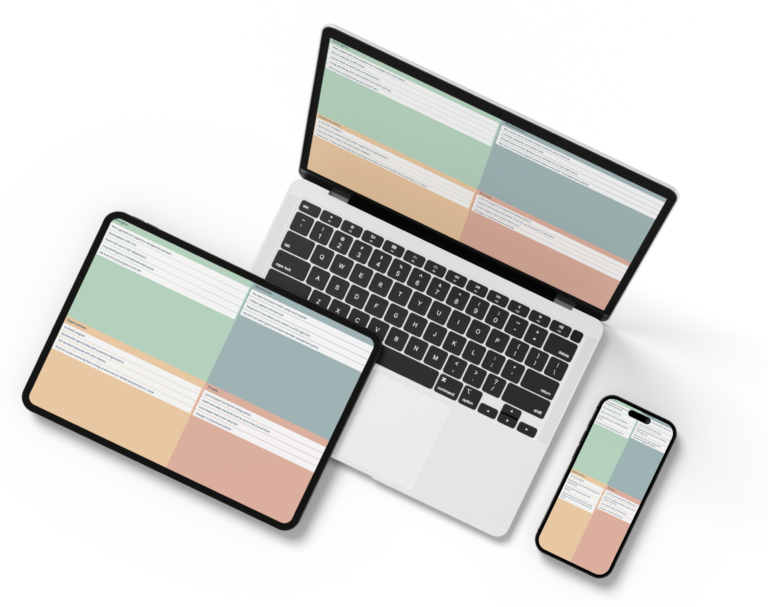
What is Group Mind Mapping?
Group mind mapping is a simple but powerful technique for generating an organized, visual representation of related ideas and information among a group of people. The process of developing a group mind map stimulates both creative and analytical thinking and is a proven and effective tool for collaborative brainstorming.
Why Use Group Mind Mapping?
The strength of group mind mapping lies in its simplicity. The technique is easy to learn and doesn’t require any specialized skills, knowledge, or equipment to facilitate in a group setting. Developing a mind map:
- Is a good way to warm up a group, get people thinking, and engage them in the topic at hand
- Is a fast and efficient way for teams generate and capture ideas
- Encourages spontaneity and creativity while maintaining a structure for the generated ideas
- Improves problem-solving and encourages bigger-picture thinking
- Helps to break down large concepts and projects into more manageable parts
- Provides an overview of the subject but can also capture a large amount of detail as layers develop
- Highlights connections between different lines of thought
Online collaboration tools like GroupMap allow you to find the best ideas with dot votes, likes, dislikes or ratings, and quickly see visually weighted results to highlight where sentiment lies.
- Automatically combine individual mind maps into an overall group mind map for review, comment, voting, and ranking
- Find the best ideas with dot votes, likes, dislikes or ratings
- Chat with other participants
- Get real-time reporting
- See how people contributed to the session
- Buzan, Tony. 2018. “Mind Map Mastery: The Complete Guide to Learning and Using the Most Powerful Thinking Tool in the Universe.” Watkins Media Limited.
- TonyBuzan Inventor Mind Mapping
Who Should Use Group Mind Mapping?
Group mind mapping is extremely versatile and can be applied in all industries, organizations, departments, and projects. Use mind maps to:
- Explore new ideas
- Plan business strategies
- Solve problems, weigh alternatives, and make decisions
- Break down concepts, ideas, plans, and projects into manageable activities
- Develop agendas for meetings
- Record notes, and organize information from group sessions
Group Mind Mapping Example

How to Develop a Group Mind Map
For group mind mapping to be successful, everyone should feel comfortable to let their ideas flow freely. For new teams, contentious topics, or groups with a distinct hierarchy, you may need to assign some degree of anonymity when capturing the ideas for this to happen. That can be difficult with traditional brainstorming tools such as whiteboards, sticky notes, and poster paper. However online collaboration tools like GroupMap makes this easy.
The time to run a group mind mapping exercise will vary depending on the complexity of the subject and the amount of detail required. Warm up activities may take just 5 minutes, whereas strategy development, problem-solving, or project planning could take an hour or more to include prioritization steps and the development of an action plan.
There are several ways to brainstorm the ideas that form the mind map. Individuals can create their own maps, and then you can amalgamate the ideas as a whole, or you can add the ideas as a group. Developing separate maps frees the participants from group think and edit wars, but it does take a more effort to collate unless you’re using a collaborative mind mapping software like GroupMap which does this automatically.

Group mind mapping starts with a blank page. You then identify the main topic for the session and add it to the center of whatever mind mapping tool you’ve chosen. Ideas that stem from this central hub branch out in a tree like structure.
Invite participants into the map by invite code or email on their laptop, PC, Mac or tablet.

Participants add ideas they associate with that topic as branches radiating from the central hub. Each idea should be expressed as a single word or short phrase, just long enough to capture the idea.
Repeat the process for each of those secondary ideas to create sub branches.
Create as many levels as you want to get a comprehensive overview of the topic. Add visual prompts by pinning pictures and using color to link similar themes. If you’re using an online collaboration tool like GroupMap, you can add files and links to support the idea where appropriate.
Once all the ideas are gathered and combined, the group can review and rank them according to their significance.


Save Effort, Time and Money with GroupMap
GroupMap offers more than just an online digital whiteboard—it’s innovative platform is designed to enhance the quality of your team’s decisions. With features that prevent bias and make facilitation seamless, GroupMap ensures no single voice dominates and ensures productive, inclusive conversations.
Its intuitive interface is easy for anyone to use, and its scalable design supports small teams and large groups whether they are face to face or around the globe. Customisable templates and workflows keep discussions focused on objectives, helping you drive actionable outcomes each and every time.
Create your first map and invite people in to start sharing their thoughts NOW.
Experience the power of GroupMap with our FREE 14 day trial.
Your free trial gives you access to all of our features, no credit card required.
